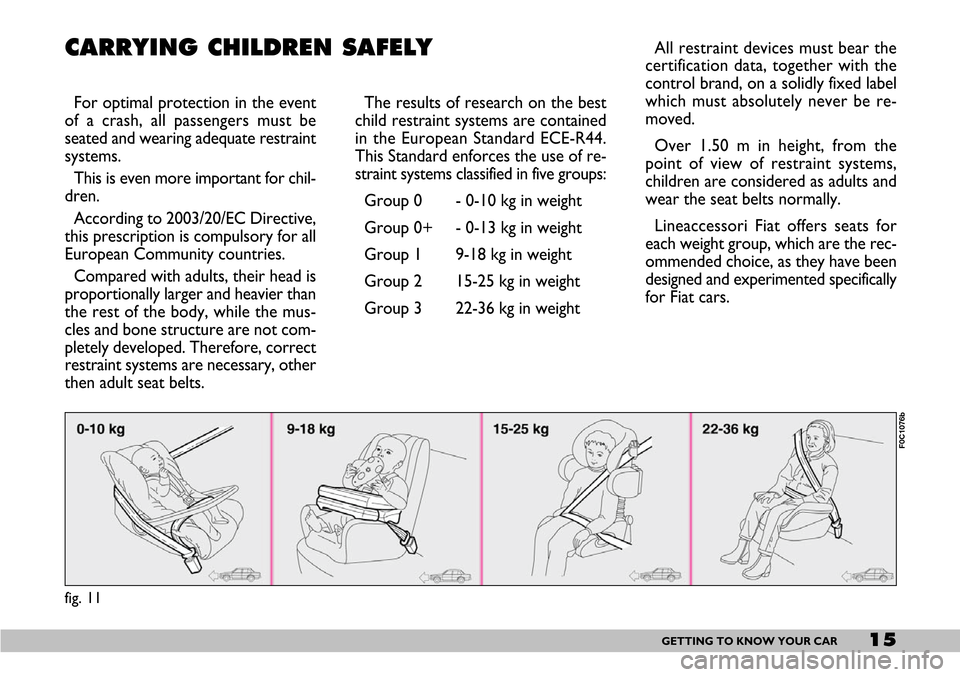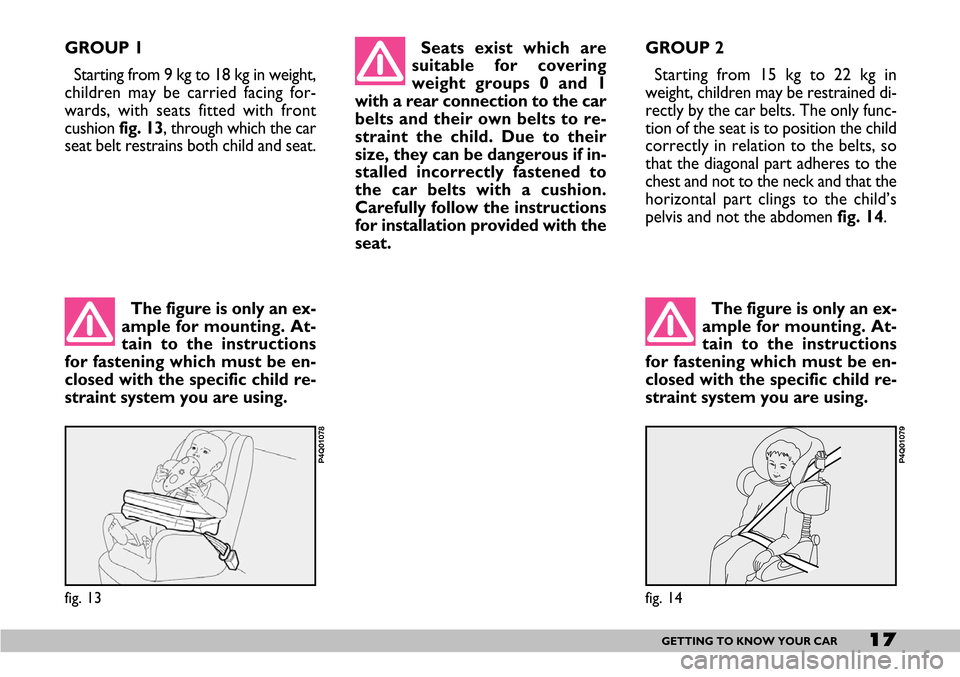2007 FIAT SEICENTO weight
[x] Cancel search: weightPage 16 of 154

15GETTING TO KNOW YOUR CAR
fig. 11
F0C1076b
CARRYING CHILDREN SAFELY
For optimal protection in the event
of a crash, all passengers must be
seated and wearing adequate restraint
systems.
This is even more important for chil-
dren.
According to 2003/20/EC Directive,
this prescription is compulsory for all
European Community countries.
Compared with adults, their head is
proportionally larger and heavier than
the rest of the body, while the mus-
cles and bone structure are not com-
pletely developed. Therefore, correct
restraint systems are necessary, other
then adult seat belts.The results of research on the best
child restraint systems are contained
in the European Standard ECE-R44.
This Standard enforces the use of re-
straint systems classified in five groups:
Group 0 - 0-10 kg in weight
Group 0+ - 0-13 kg in weight
Group 1 9-18 kg in weight
Group 2 15-25 kg in weight
Group 3 22-36 kg in weightAll restraint devices must bear the
certification data, together with the
control brand, on a solidly fixed label
which must absolutely never be re-
moved.
Over 1.50 m in height, from the
point of view of restraint systems,
children are considered as adults and
wear the seat belts normally.
Lineaccessori Fiat offers seats for
each weight group, which are the rec-
ommended choice, as they have been
designed and experimented specifically
for Fiat cars.
Page 18 of 154

17GETTING TO KNOW YOUR CAR
fig. 13
P4Q01078
The figure is only an ex-
ample for mounting. At-
tain to the instructions
for fastening which must be en-
closed with the specific child re-
straint system you are using.
GROUP 1
Starting from 9 kg to 18 kg in weight,
children may be carried facing for-
wards, with seats fitted with front
cushion fig. 13, through which the car
seat belt restrains both child and seat.Seats exist which are
suitable for covering
weight groups 0 and 1
with a rear connection to the car
belts and their own belts to re-
straint the child. Due to their
size, they can be dangerous if in-
stalled incorrectly fastened to
the car belts with a cushion.
Carefully follow the instructions
for installation provided with the
seat.
fig. 14
P4Q01079
The figure is only an ex-
ample for mounting. At-
tain to the instructions
for fastening which must be en-
closed with the specific child re-
straint system you are using.
GROUP 2
Starting from 15 kg to 22 kg in
weight, children may be restrained di-
rectly by the car belts. The only func-
tion of the seat is to position the child
correctly in relation to the belts, so
that the diagonal part adheres to the
chest and not to the neck and that the
horizontal part clings to the child’s
pelvis and not the abdomen fig. 14.
Page 19 of 154

18GETTING TO KNOW YOUR CAR
Group Range Front Rear side Central
of weight passenger passenger Rear side
passenger
(if any)
Group 0, 0+ up to 13 kg U U (*)
Group 1 9-18 kg U U (*)
Group 2 15-25 kg U U (*)
Group 3 22-36 kg U U (*)
fig. 15
P4Q01080
GROUP 3
Starting from 22 kg to 36 kg in
weight, the size of the child’s chest no
longer requires a support to space the
child’s back from the seat back.
Fig. 15shows an example of proper
child positioning on the rear seat.
Children taller than 1.50 m can wear
seat belts like adults.PASSENGER SEATS
COMPLIANCE WITH
REGULATIONS ON CHILD’S
SEAT USE
Fiat 600 complies with the new
2000/3/EC Directive regulating child’s
seat assembling on the different car
seats according to the table on next
page.Key for the table on next page.
U = suitable for child restraint systems of the
“Universal” category, according to Euro-
pean Standard ECE R44 for the specified
“Groups”.
(*) No child’s seat can be installed on the rear
seat with lap belt (without reel).
Page 48 of 154

47GETTING TO KNOW YOUR CAR
BOOT
OPENING/CLOSING
THE TAILGATE
For sedan versions, the boot tailgate
can only be opened from the passen-
ger compartment using lever A-
fig. 66.
To open the boot from the outside
(VAN versions only), unlock it with
the ignition key fig. 64.
fig. 64
P4Q00066
Do not unlock the boot
while the car is in motion.
To open it from inside the car, pull
lever A-fig. 66at the side of the dri-
ver’s seat.
The opening of the boot is made
easier by the gas-filed struts on each
side.
To close the boot, lower it and press
the lock or the Fiat logo until it clicks.
A hole fig. 65in the inside of the
tailgate is provided to offer an easy
grip for closing the tailgate. When using the boot,
make sure that the load
you are carrying does not
exceed the permitted weight
(see
TECHNICAL SPECIFICATIONS).
Also ensure that the items in the
boot are arranged properly to
prevent them being thrown for-
wards and injuring passengers
should you brake sharply.
Never travel with the
boot open: the exhaust
fumes could enter the
passenger compartment.
fig. 65
P4Q01048
fig. 66
P4Q00024
Page 54 of 154

53GETTING TO KNOW YOUR CAR
After travelling a few
kilometres, check that
the screws securing the
attachments are tight.
Never exceed the per-
mitted weight (see
TECH-
NICAL SPECIFICATIONS). SLANT COMPENSATION
When the car is loaded, it slopes
backwards. This means that the head-
light beam rises. In this case, it is nec-
essary to return it to the correct po-
sition.
The headlight beam adjuster is lo-
cated inside the car on the right side
of the steering column fig. 78.
Position 0- one or two occupants in
the front seats.
Position 1- five occupants.
Position 2- five occupants + load in
boot.
Position 3- driver + maximum per-
missible load stowed in boot.
Be careful not to knock
objects on the roof rack
when opening the tail-
gate.
HEADLIGHTS
ADJUSTING THE
HEADLIGHT BEAM
The correct positioning of the head-
light beams is very important for the
comfort and safety, not only of the
person driving the car but also all
other road users.
This is also covered by a specific law.
To ensure you and other drivers
have the best visibility conditions
when travelling with the headlights on,
the headlights must be set properly.
Have the headlight positioning
checked at a Fiat Dealershipand
adjusted if necessary.
fig. 78
P4Q01016Check the positioning of
the headlight beams
every time you change
the load to be carried.
Page 63 of 154

62GETTING TO KNOW YOUR CAR
The system is programmed at the
factory to ensure variable degrees of
assistance according to the require-
ments. In other words, power is in-
creased for parking and reduced as
the car’s speed increases.
The EPAS system only works when
the engine is running to avoid deploy-
ing the battery accidentally. Further-
more, it is equipped with a self-test
function to detect faults and incorrect
signals.
IMPORTANTThe steering wheel
may stiffen slightly in parking manoeu-
vres requiring a great deal of steering:
this is normal and caused by the
power steering motor overheat pro-
tection system tripping. The problem
does not require servicing and the
electric power steering system will
work normally the next time the car
is used.If the warning light comes on, see
chapter
GETTING TO KNOW YOUR CAR,
paragraph
WARNING LIGHTS.
FIAT 600 VAN
The version herein illustrated differs
from Fiat 600 saloon described in this
handbook for the different size of the
boot and the availability of two front
seats only.
Load recommendations
Fiat 600 Van has been designed and
approved on the basis of several set
maximum values:
– kerb weight
– payload
– gross vehicle weight
– total weight on the front axle
– total weight on the rear axle
– towable weight.
Each of these limits must be borne
in mind and must never be exceeded
under any circumstances. It is absolutely forbidden
to carry out whatever af-
ter-market operation in-
volving steering system or steer-
ing column modifications (e.g.: in-
stallation of anti-theft Device)
that could badly affect perfor-
mance and safety, cause the lapse
of warranty and also result in
non-compliance of the car with
homologation requirements.
Page 64 of 154

63GETTING TO KNOW YOUR CAR
IMPORTANT Sudden braking or
collisions can cause sudden shifts of
the load which could jeopardise the
safety of the driver and the passen-
gers: before you start off make sure
the load is firmly secured.Use metal cables, ropes or straps
strong enough to support the weight
of the load to be fixed.In addition to these general precau-
tions, some simple measures could
enhance driving safety, comfort and
the length of your vehicle’s life:
– distribute the load evenly over the
load floor: if you need to concentrate
it all in one point choose the part be-
tween the axles;
– remember that the lower the load
is, the lower the vehicle’s centre of
gravity will be, contributing to a safe
drive; you should therefore always po-
sition the heavier goods at the bottom;
– finally, remember that the way in
which the vehicle moves is influenced
by the weight being carried. In partic-
ular, stopping distance lengthens par-
ticularly at high speed.
P4Q00568
fig. 83
Page 79 of 154

78DRIVING YOUR CAR
Tyres
Tyre pressure should be checked at
least once every four weeks: if the
pressure is too low fuel consumption
increases as the resistance to the
rolling movement of the tyre is
greater. In this state, tyre wear is in-
creased and vehicle handling suffers
which will effect safety.
Unnecessary loads
Do not travel with too much luggage
stowed in the boot. The weight of the
vehicle and its trim greatly effects con-
sumption and stability.
Roof rack/ski rack
Remove roof racks and ski racks
from the roof of the car as soon as
they are no longer needed. These ac-
cessories reduce the aerodynamic
penetration of the vehicle and will in-
crease consumption. When having to
transport particularly large loads it is
better to use a trailer.Electric devices
Use electric devices for the neces-
sary time only. The heated rear win-
dow, fog lights, windscreen wipers,
heating system blower require large
amounts of electricity, and as a con-
sequence, the fuel consumption in-
creases (up to +25% in town).
Climate control system
The climate control system is a fur-
ther drag on the engine causing higher
fuel consumption (on average, up to
20%). When outside temperatures
permit, use the vents.
Aerodynamic accessories
The use of aerodynamic accessories
not certified for that specific purpose
can diminish the car’s aerodynamic
penetration and increase consump-
tion.BEHIND THE WHEEL
Starting-up
Do not warm up the engine when
the car is stationary, neither by idling
nor revving up. If you do, the engine
will warm up much more slowly and
increase fuel consumption and emis-
sions. It is therefore better to start
slowly and to keep the engine speed
down.
Unnecessary manoeuvres
Do not give quick bursts on the ac-
celerator when waiting at the traffic
lights or before turning off the engine.
This type of action, like the “double
clutch” are absolutely useless on mod-
ern cars. They only increase fuel con-
sumption and pollution.
Gear selection
As soon as traffic conditions allow,
shift up to a higher gear. Using a low
gear to have a sharp acceleration in-
creases the consumption. Likewise,
using a high gear when this is not
called for increases consumption,
emissions and wear on the engine.